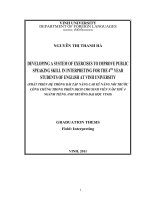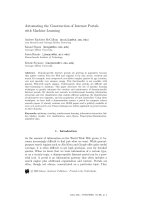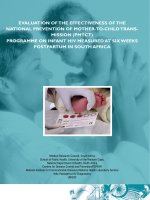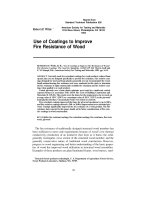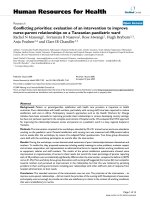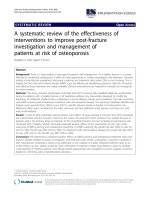Incorporation of constraints to improve machine learning approaches on coreference resolution
Bạn đang xem bản rút gọn của tài liệu. Xem và tải ngay bản đầy đủ của tài liệu tại đây (409.27 KB, 119 trang )
INCORPORATION OF CONSTRAINTS TO IMPROVE
MACHINE LEARNING APPROACHES ON
COREFERENCE RESOLUTION
CEN CEN
(MSc. NUS)
A THESIS SUBMITTED
FOR THE DEGREE OF MASTER OF SCIENCE
SCHOOL OF COMPUTING
NATIONAL UNVIERSITY OF SINGAPORE
2004
Incorporation of constraints to improve machine learning approaches on coreference resolution
Acknowledgements
I would like to say “Thank You” to everyone who has helped me during the course of
the research. Without their support, the research would not be possible.
My first thanks go to thank my supervisor, Associate Professor Lee Wee Sun, for his
invaluable guidance and assistance. I am always inspired by his ideas and visions. I
cannot thank him enough.
I also want to say thank you to many others - Yun Yun, Miao Xiaoping, Huang
Xiaoning, Wang Yunyan and Yin Jun. Their suggestions and concern for me put me
always in a happy mood during this period.
Last but not least, I wish to thank my friend in China, Xu Sheng, for his moral support.
His encouragement is priceless.
-1-
Incorporation of constraints to improve machine learning approaches on coreference resolution
Content
List of Figures
6
List of Tables
7
Summary
8
1.
Introduction
9
1.1.
Coreference Resolution
9
1.1.1. Problem Statement
9
1.1.2. Applications of Coreference Resolution
1.2.
Terminology
11
1.3.
Introduction
12
1.4.
2.
10
1.3.1. Related Work
12
1.3.2. Motivation
18
Structure of the thesis
20
Natural Language Processing Pipeline
22
2.1.
Markables Definition
22
2.2.
Markables Determination
23
2.2.1. Toolkits used in NLP Pipeline
24
2.2.2. Nested Noun phrase Extraction
26
-2-
Incorporation of constraints to improve machine learning approaches on coreference resolution
3.
4.
2.2.3. Semantic Class Determination
27
2.2.4. Head Noun Phrases Extraction
27
2.2.5. Proper Name Identification
30
2.2.6. NLP Pipeline Evaluation
32
The Baseline Coreference System
36
3.1.
Feature Vector
36
3.2.
Classifier
38
3.2.1. Training Part
38
3.2.2. Testing Part
40
Ranked Constraints
42
4.1.
43
4.2.
Ranked Constraints in coreference resolution
4.1.1. Linguistic Knowledge and Machine Learning Rules
43
4.1.2. Pair-level Constraints and Markable-level Constraints
47
4.1.3. Un-ranked Constraints vs. Ranked Constraints
48
4.1.4. Unsupervised and Supervised approach
49
Ranked Constraints Definition
52
4.2.1. Must-link
53
4.2.2. Cannot-link
55
4.2.3. Markable-level constraints
58
-3-
Incorporation of constraints to improve machine learning approaches on coreference resolution
4.3.
5.
6.
Multi-link Clustering Algorithm
60
Conflict Resolution
64
5.1.
Conflict
64
5.2.
Main Algorithm
67
5.2.1. Coreference tree
68
5.2.2. Conflict Detection and Separating Link
71
5.2.3. Manipulation of Coreference Tree
74
Evaluation
81
6.1.
Score
81
6.2.
The contribution of constraints
87
6.2.1. Contribution of Each Constraints Group
88
6.2.2. Contribution of Each Combination of Constraints Group
89
6.2.3. Contribution of Each Constraint in ML and CL
94
6.3.
The contribution of conflict resolution
6.4.
Error analysis
97
101
6.4.1. Errors Made by NLP
102
6.4.2. Errors Made by ML
103
6.4.3. Errors Made by MLS
104
6.4.4. Errors Made by CL
105
-4-
Incorporation of constraints to improve machine learning approaches on coreference resolution
7.
6.4.5. Errors Made by CLA
105
6.4.6. Errors Made by CR
106
6.4.7. Errors Made by Baseline
106
Conclusion
108
7.1.1. Two Contributions
108
7.1.2. Future Work
109
Appendix A : Name List
111
A.1 Man Name List
111
A.2 Woman Name List
112
Appendix B: MUC-7 Sample
113
B.1 Sample MUC-7 Text
113
B.2 Sample MUC-7 Key
113
Bibliography
115
-5-
Incorporation of constraints to improve machine learning approaches on coreference resolution
List of Figures
Figures
Page
2.1
The architecture of natural language procession pipeline
23
2.2
The noun phrase extraction algorithm
28
2.3
The proper name identification algorithm
31
3.1
The decision tree classifier
41
4.1
The algorithm of coreference chains generation with constraints
62
5.1
An example of conflict resolution
66
5.2
An example of coreference tree in MUC-7
70
5.3
The algorithm to detect conflict and find separating link
71
5.4
An example of extending coreference tree
73
5.5
The Add function of the algorithm of coreference chain generation
74
5.6
An example of merging coreference trees
76
5.7
Examples of separating coreference tree
77
5.8
The result of separating the tree with conflict shown in Figure 5.4
78
6.1
Results for the effects of ranked constraints and conflict resolution
84
6.2
Results to study the contribution of each constraints group
86
6.3
Results for each combination of four constraint groups
89
6.4
Results to study the effect of ML and CL
90
6.5
Results to study the effect of CLA and MLS
91
-6-
Incorporation of constraints to improve machine learning approaches on coreference resolution
List of Tables
Table
Page
2.1
MUC-7 results to study the two additions to NLP pipeline
33
3.1
Feature set for the duplicated Soon baseline system
37
4.1
Ranked Constraints set used in our system
61
6.1
Results for formal data in terms of result, precision and F-measure
81
6.2
Results for to study the ranked constraints and conflict resolution
83
6.3
Results for each combination of four constraint groups
89
6.4
Results for coreference system to study the effect of each constraint
94
6.5
Errors in our complete system
100
-7-
Incorporation of constraints to improve machine learning approaches on coreference resolution
Summary
In this thesis, we utilize linguistic knowledge to improve coreference resolution
systems built through a machine learning approach. The improvement is the result of
two main ideas: incorporation of multi-level ranked constraints based on linguistic
knowledge and conflict resolution for handling conflicting constraints within a set of
corefering elements. The method resolves problems with using machine learning for
building coreference resolution systems, primarily the problem of having limited
amounts of training data. The method provides a bridge between coreference
resolution methods built using linguistic knowledge and machine learning methods. It
outperforms earlier machine learning approaches on MUC-7 data increasing the
F-measure of a baseline system built using a machine learning method from 60.9% to
64.2%.
-8-
Incorporation of constraints to improve machine learning approaches on coreference resolution
1. Introduction
1.1. Coreference Resolution
1.1.1. Problem Statement
Coreference resolution is the process of collecting together all expressions which refer
to the same real-world entity mentioned in a document. The problem can be recast as a
classification problem: given two expressions, do they refer to the same entity or
different entities. It is a very critical component of Information Extraction systems.
Because of its importance in Information Extraction (IE) tasks, the DARPA Message
Understanding Conferences have taken coreference resolution as an independent task
and evaluated it separately since MUC-6 [MUC-6, 1995]. Up to now, there have been
two MUCs, MUC-6 [MUC-6, 1995] and MUC-7 [MUC-7, 1997] which involve the
evaluation of coreference task.
In this thesis, we focus on the coreference task of MUC-7 [MUC-7, 1997]. MUC-7
[MUC-7, 1997] has a standard set of 30 dry-run documents annotated with coreference
information which is used for training and a set of 20 test documents which is used in
the evaluation. They are both retrieved from the corpus of New York Times News
Service and have different domains.
-9-
Incorporation of constraints to improve machine learning approaches on coreference resolution
1.1.2. Applications of Coreference Resolution
Information Extraction
An Information Extraction (IE) system is used to identify information of interest from
a collection of documents. Hence an Information Extraction (IE) system must
frequently extract information from documents containing pronouns. Furthermore, in a
document, the entity including interesting information is often mentioned in different
places and in different ways. The coreference resolution can capture such information
for the Information Extraction (IE) system. In the context of MUC, the coreference
task also provides the input to the template element task and the scenario template task.
However its most important criterion is the support for the MUC Information
Extraction tasks.
Text Summarization
Many text summarization systems include the component for selecting the important
sentences from a source document and using them to form a summary. These systems
could encounter some sentences which contain pronouns. In this case, coreference
resolution is required to determine the referents of pronouns in the source document
and replace these pronouns.
Human-computer interaction
Human-computer interaction needs computer system to provide the ability to
understand the user’s utterances. Human dialogue generally contains many pronouns
- 10 -
Incorporation of constraints to improve machine learning approaches on coreference resolution
and similar types of expressions. Thus, the system must figure out what the pronouns
denote in order to “understand” the user’s utterances.
1.2. Terminology
In this section, the concepts and definitions used in this thesis are introduced.
In a document, the expressions that can be part of coreference relations are called
markables. Markable includes three categories: noun, noun phrase and pronoun. A
markable used to perform reference is called the referring expression, and the entity
that is referred to is called the referent. Sometimes a referring expression is referred as
a referent. If two referring expressions refer to each other, they corefer in the document
and are called coreference pair. The first markable in a coreference pair is called
antecedent and the second markable is called anaphor. When the coreference relation
between two markables is not confirmed, the two markables constitute a possible
coreference pair, and the first one is called possible antecedent and the second is
possible anaphor. Only those markables which are anaphoric can be anaphors. All
referring expressions referring to the same entity in a document constitute a
coreference chain. In order to determine a coreference pair, a feature vector is
calculated for each possible coreference pair. The feature vector is the basis of the
classifier model.
For the sake of evaluation, we constructed the system’s output according to the
requirement of MUC-7 [MUC-7, 1997]. The output is called responses and the key file
is offered by MUC-7 [MUC-7, 1997] keys. A coreference system is evaluated
- 11 -
Incorporation of constraints to improve machine learning approaches on coreference resolution
according to three criteria: recall, precision and F-measure [Amit and Baldwin, 1998].
1.3. Introduction
1.3.1. Related Work
In coreference resolution, so far, there are two different but complementary approaches:
one is theory-oriented rule-based approach and the other is empirical corpus-based
approach.
Theory-oriented Rule-based Model
Theory-oriented rule-based approaches [ Mitkov, 1997; Baldwin, 1995; Charniak,
1972] employ manually encoded heuristics to determine coreference relationship.
These manual approaches require the information encoded by knowledge engineers:
features of each markable, rules to form coreference pairs, and the order of these rules.
Because coreference resolution is a linguistics problem, most rule-based approaches
more or less employ theoretical linguistic work, such as Focusing Theory [Grosz et al.,
1977; Sidner, 1979], Centering Theory [Grosz et al., 1995] and the systemic theory
[Halliday and Hasan, 1976]. The manually encoded rules incorporate background
knowledge into coreference resolution. Within a specific knowledge domain, the
approaches achieve a high precision (around 70%) and a good recall (around 60%).
However, language is hard to be captured by a set of rules. Almost no linguistic rule
can be guaranteed to be 100% accurate. Hence, rule-based approaches are subject to
three disadvantages as follows:
- 12 -
Incorporation of constraints to improve machine learning approaches on coreference resolution
1) Features, rules and the order of the rules need to be determined by knowledge
engineers.
2) The existence of an optimal set of features, rules and an optimal arrangement
of the rules set has not been conclusively established.
3) A set of features, rules and the arrangement of rules depend much on
knowledge domain. Even though a set of features, rules and the arrangement
can work well in one knowledge domain, they may not work as well in other
knowledge domains. Therefore if the knowledge domain is changed, the set
of features, rules and the arrangement of the rules set need to be tuned
manually again.
Hence considering these disadvantages, further manual refinement of theory-oriented
rule-based models will be very costly and it is still far from being satisfactory for many
practical applications.
Corpus-based Empirical Model
Corpus-based empirical approaches aree reasonably successful and achieve a
performance comparable to the best-performing rule-based systems for the coreference
task’s test sets of MUC-6 [ MUC-6, 1995] and MUC-7 [ MUC-7, 1997]. Compared to
rule-based approaches, corpus-based approaches have following advantages:
1) They are not as sensitive to knowledge domain as rule-based approaches.
2) They use machine learning algorithms to extract rules and arrange the rules
set in order to eliminate the requirement for the knowledge engineer to
- 13 -
Incorporation of constraints to improve machine learning approaches on coreference resolution
determine the rules set and arrangement of the set. Therefore, they are more
cost-effective.
3) They provide a flexible mechanism for coordinating context-independent and
context-dependent coreference constraints.
Corpus-based empirical approaches are divided into two groups: one is supervised
machine learning approach [Aone and Bennett, 1995; McCarthy, 1996; Soon et al.,
2001; Ng and Cardie, 2002a; Ng and Cardie, 2002; Yang et al., 2003], which recasts
coreference problem as a binary classification problem; the other is unsupervised
approach, such as [Cardie and Wagstaff, 1999], which recasts coreference problem as a
clustering task. In recent years, supervised machine learning approach has been widely
used in coreference resolution. In most supervised machine learning systems [e.g.
Soon et al., 2001; Ng and Cardie, 2002a], a set of features is devised to determine
coreference relationship between two markables. Rules are learned from these features
extracted from training set. For each possible anaphor which is considered in test
document, its possible antecedent is searched for in the preceding part of the document.
Each time, a pair of markables is found, it will be tested using those rules. This is
called the single-candidate model [Yang et al., 2003]. Although these approaches have
achieved significant success, the following disadvantages exist:
Limitation of training data
The limitation of training data is mostly due to training data insufficiency and “hard”
training examples.
- 14 -
Incorporation of constraints to improve machine learning approaches on coreference resolution
Because of insufficiency of training data, corpus-based model cannot learn sufficiently
accurate rules to determine coreference relationship in test set. In [Soon et al., 2001;
Ng and Cardie, 2002a], they used 30 dryrun documents to train their coreference
decision tree. But coreference is a rare relation [See Ng and Cardie, 2002]. In [Soon et
al., 2001]’s system, only about 2150 positive training pairs were extracted from
MUC-7 [MUC-7, 1997], but the negative pairs were up to 46722. Accordingly the
class distributions of the training data are highly skewed. Learning in the presence of
such skewed class distributions results in models, which tend to determine that a
possible coreference pair is not coreferential. This makes the system’s recall drop
significantly. Furthermore, insufficient training data may result in some rules being
missed. For example, if within a possible coreference pair, one is another’s appositive,
the pair should be a coreference pair. However, appositives are rare in training
documents, and it cannot be determined easily. As a result, the model may not include
the appositive rule. This obviously influences the accuracy of coreference system.
During the sampling of positive training pair, if the types of noun phrases are ignored,
it would result in “hard” training example [Ng and Cardie, 2002]. For example, the
interpretation of a pronoun may be dependent only on its closest antecedent and not on
the rest of the members of the same coreference chain. For proper name resolution, the
string matching or more sophisticated aliasing techniques would be better for training
example generation. Consequently, generation of positive training pairs without
consideration of noun phrase types may induce some “hard” training instances. “Hard”
training pair is coreference pair in its coreference chain, but many pairs with the same
- 15 -
Incorporation of constraints to improve machine learning approaches on coreference resolution
feature vectors with the pair may not be coreference pairs. “Hard” training instances
would lead to some rules which are hazardous for performance. How to deal with such
limitation of training data remains an open area of research in the machine learning
community. In order to avoid the influence of training data, [Ng and Cardie, 2002]
proposed a technique of negative training example selection similar to that proposed in
[Soon et al., 2001] and a corpus-based method for implicit selection of positive
training examples. Therefore the system got a better performance.
Considering coreference relationship in isolation
In most supervised machine learning systems [Soon et al., 2001; Ng and Cardie,
2002a], when the model determines whether a possible coreference pair is a
coreference pair or not, each time it only considers the relationship between two
markables. Even if the model’s feature sets include context-dependent information, the
context-dependent information is only about one markable, not both two markables.
For example, so far, no coreference system cares about that how many pronouns
appear between two markables in a document. Therefore only local information of two
markables is used and global information in a document is neglected. [Yang et al.,
2003] suggested that whether a candidate is coreferential to an anaphor is determined
by the competition among all the candidates. Therefore, they proposed a
twin-candidate model compared to the single-candidate model. Such approach
empirically outperformed those based on a single-candidate model. The paper implied
that it is potentially better to incorporate more context-dependent information into
- 16 -
Incorporation of constraints to improve machine learning approaches on coreference resolution
coreference resolution. Furthermore, because of incomplete rules set, the model may
determine that (A, B) is a coreference pair and (B, C) is a coreference pair. But actually,
(A, C) is not a coreference pair. This is a conflict in a coreference chain. So far, most
systems do not consider conflicts within one coreference chain. [Ng and Cardie, 2002]
noticed the conflicts. They claimed that these were due to classification error. To avoid
such conflicts, they incorporated error-driven pruning of classification rule set to avoid.
However Ng and Cardie, 2002 did not take the whole coreference chain’s information
into account either.
Lack of an appropriate reference to theoretical linguistic work on coreference
Basically, coreference resolution is a linguistic problem and machine learning is an
approach to learn those linguistic rules in training data. As we have mentioned above,
training data has its disadvantages and it may lead to missing some rules which can be
simply formulated manually. Moreover, current machine learning approaches usually
embed some background knowledge into the feature set, hoping the machine could
learn such rules from these features. However, “hard” training examples influence the
rules-learning. As a result, such simple rules are missed by the machine.
Furthermore, it is still a difficult task to extract the optimal features set. [Ng and Cardie,
2002a] incorporated a feature set including 53 features, larger than [Soon et al.,
2001]’s 12 features set. It is interesting that such large feature set did not improve
system performance and even degraded the performance significantly. Instead,
[Wagstaff, 2002] incorporated some linguistic rules into coreference resolution directly
- 17 -
Incorporation of constraints to improve machine learning approaches on coreference resolution
and the performance increased noticeably. Therefore, there is no 100% accurate
machine learning approach. However, simple rules can make up for the weakness.
Another successful example is [Iida et al., 2003] who incorporated more linguistic
features capturing contextual information and obtained a noticeable improvement over
their baseline systems.
1.3.2. Motivation
Motivated by the analysis of current coreference system, in this thesis, we propose a
method to improve current supervised machine learning coreference resolution by
incorporating a set of ranked linguistic constraints and a conflict resolution method.
Ranked Constraints
Directly incorporating linguistic constraints makes a bridge between theoretical
linguistic findings and corpus-based empirical methods. As we have mentioned above,
machine learning can lead to missing rules. In order to avoid missing rules and to
encode domain knowledge that is heuristic or approximate, we devised a set of
constraints, some of which can be violated and some of which cannot. The constraints
are seen as ranked constraints and those which cannot be violated are provided with
the infinite rank. In this way, the inflexibility of those rule-based systems is avoided.
Furthermore, our constraints include two-level of information: one is pair level and the
other is markable level. Pair-level constraints include must-link and cannot-link. They
are simple rules based two markables. Markable-level constraints consist of
cannot-link-to-anything and must-link-to-something. They are based on single
- 18 -
Incorporation of constraints to improve machine learning approaches on coreference resolution
markable. And they guide the system to treate anaphors differently. All of them can be
simply tested. And the most important is that the constraints avoid overlooking local
information by using global information from the whole documents, while current
machine learning methods do not pay enough attention to the global information. By
incorporating constraints, each anaphor can have more than one antecedent. Hence the
system replaces the single-link clustering with multi-link clustering (described in
Chapter 4). For example, one of the constraints indicates that proper names with the
same surface string in a document should belong to the same equivalence class.
Conflict Resolution:
As we mentioned above, in testing, conflicts may appear in a coreference chain. This
should be reliable signal of error. In this thesis, we also proposed an approach to make
use of the signals to improve the system performance. When conflict arises, the
conflict is measured and a corresponding process is called to deal with the conflicts.
Because of the use of conflict resolution, the ranked constraint’s reliability is reduced.
Hence the constraints become more heuristic and approximate. As a result, the
system’s recall is improved significantly (from 59.6 to 63.8) and precision is improved
at the same time (from 61.7 to 64.1).
We observed that by incorporating some simple linguistic knowledge, constraints and
conflict resolution can reduce the influence of training data limitation to a certain
extent. By devising multi-level constraints and using the coreference chain’s
information, coreference relationship becomes more global, not isolated. In the
- 19 -
Incorporation of constraints to improve machine learning approaches on coreference resolution
following chapter, we show how the new approach achieves the F-measure of 64.2
outperforming earlier machine learning approaches, such as [Soon et al., 2001]’s 60.4
and [Ng and Cardie, 2002a]’s 63.4.
In this thesis, we duplicated Soon work as the baseline for our work. Before we
incorporated constraints and conflict resolution, we added two more steps, head noun
phrase extraction and proper name identification, into Natural Language Processing
(NLP) pipeline. By doing so, the baseline system’s performance increases from 59.3 to
60.9 and consequently achieves an acceptable performance. In Chapter 2, the two
additions are described in detail.
1.4. Structure of the thesis
The rest of the thesis is organized as follows:
Chapter 2 and Chapter 3 will introduce the baseline system’s implementation. Chapter
2 will introduce the natural language processing pipeline used in our system and
describe the two additional steps, noun phrase extraction and proper name
identification, and the corresponding experimental result. Chapter 3 will introduce the
baseline system based on [Soon et al., 2001] in brief.
Chapter 4 and Chapter 5 will introduce our approach in detail. Ranked constraints will
be introduced in Chapter 4. In this Chapter, we will give the types and definitions of
constraints we incorporate in our system. Chapter 5 will describe the conflict
resolution algorithm in detail.
In Chapter 6, we will evaluate our system, by comparing it with some existing systems,
- 20 -
Incorporation of constraints to improve machine learning approaches on coreference resolution
such as [Soon et al., 2001]. And we also show the contributions of constraints and
conflict resolution respectively. At the end of this chapter, we will analyze the
remaining errors in our system.
Chapter 7 will conclude the thesis, highlight its contributions to coreference resolution
and describe the future work.
- 21 -
Incorporation of constraints to improve machine learning approaches on coreference resolution
2. Natural Language Processing Pipeline
2.1. Markables Definition
Candidate which can be part of coreference chains are called markable in MUC-7
[ MUC-7, 1997]. According to the definition of MUC-7 [ MUC-7, 1997] Coreference
Task, markables include three categories whether it is the object of an assertion, a
negation, or a question: noun, noun phrase and pronoun. Dates, currency expression
and percentage are also considered as markables. However interrogative "wh-" noun
phrases are not markables.
Markable extraction is a critical component of coreference resolution, although it does
not take part in coreference relationship determination directly. In the training part, two
referring expressions cannot form a training positive pair if either of them is not
recognized as markable by the markable extraction component even if they belong to
the same coreference chain. In the testing part, only markables can be considered as a
possible anaphor or a possible antecedent. Those expressions which are not markables
will be skipped. In this case markable extraction component performance is an
important factor in coreference system’s recall. It also means markable extraction
component performance determines the maximum value of recall.
- 22 -
Incorporation of constraints to improve machine learning approaches on coreference resolution
2.2. Markables Determination
In this thesis, a pipeline of natural language processing (NLP) is used as shown in
Figure 2.1. It has two primary functions. One is to extract markables from free text as
actually as possible and at the same time determine the boundary of those markables.
The other is to extract linguistic information which will be used in later coreference
relationship determination. Our pipeline of natural language processing (NLP) imitates
the architecture of the one used in [Soon et al., 2001]. Both pipelines consist of
tokenization, sentence segmentation, morphological processing, part-of-speech tagging,
noun phrase identification, named entity recognition, nested noun phrase extraction
Free text
Tokenization & Sentence Segmentation
Morphological Processing & POS tagging
Noun Phrase Identification
Nested Noun Phrases
Extraction
Name Entity
Recognition
Semantic Class Determination
Head Noun Phrases Extraction
Proper Name Identification
Markables
Figure 2.1
The architecture of natural language processing pipeline.
- 23 -
Incorporation of constraints to improve machine learning approaches on coreference resolution
and semantic class determination. Besides these modules, our NLP pipeline adds head
noun phrase extraction and proper name identification to enhance the performance of
NLP pipeline and to compensate the use of a weak named entity recognition that we
used. This will be discussed in detail later.
2.2.1. Toolkits used in NLP Pipeline
In our NLP pipeline, three toolkits are used to complete the task of tokenization,
sentence segmentation, morphological processing, part-of-speech tagging, noun phrase
identification and named entity recognition.
LT TTT [Grover et al., 2000], a text tokenization system and toolset which enables
users to produce a swift and individually-tailored tokenization of text, is used to do
tokenization and sentence segmentation. It uses a set of hand-craft rules to token input
SIML files and uses a statistical sentence boundary disambiguator which determines
whether a full-stop is part of an abbreviation or a marker of a sentence boundary.
LT CHUNK [LT CHUNK, 1997], a surface parser which identifies noun groups and
verb groups, is used to do morphological processing, part-of-speech tagging and noun
phrase identification. It as well as LT TTT [Grover et al., 2000] is offered by the
Language Technology Group [LTG]. LT CHUNK [LT CHUNK, 1997] is a partial
parser, which uses the part-of-speech information provided by a nested tagger and
employs mildly context-sensitive grammars to detect boundaries of syntactic groups. It
can identify simple noun phrases. Nested noun phrases, conjunctive noun phrases as
well as noun phrases with post-modifiers cannot be recognized correctly. Consider the
- 24 -
